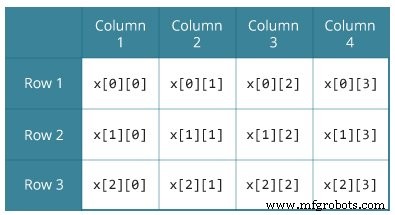C 언어








이 튜토리얼에서는 예제를 통해 다차원 배열(2차원 및 3차원 배열)을 사용하는 방법을 배웁니다.
C 프로그래밍에서는 배열의 배열을 만들 수 있습니다. 이러한 배열을 다차원 배열이라고 합니다. 예를 들어,
float x[3][4]; 여기서 x 2차원(2d) 배열입니다. 배열은 12개의 요소를 포함할 수 있습니다. 배열은 행이 3개이고 각 행에 열이 4개 있는 테이블로 생각할 수 있습니다.
<그림>
마찬가지로 3차원(3d) 배열을 선언할 수 있습니다. 예를 들어,
float y[2][4][3]; 여기서 배열 y 24개의 요소를 담을 수 있습니다.
<시간>2차원 및 3차원 배열을 초기화하는 방법은 다음과 같습니다.
<시간>
// Different ways to initialize two-dimensional array
int c[2][3] = {{1, 3, 0}, {-1, 5, 9}};
int c[][3] = {{1, 3, 0}, {-1, 5, 9}};
int c[2][3] = {1, 3, 0, -1, 5, 9};
<시간>
2차원 배열과 유사한 방식으로 3차원 배열을 초기화할 수 있습니다. 다음은 예입니다.
int test[2][3][4] = {
{{3, 4, 2, 3}, {0, -3, 9, 11}, {23, 12, 23, 2}},
{{13, 4, 56, 3}, {5, 9, 3, 5}, {3, 1, 4, 9}}}; <시간>
// C program to store temperature of two cities of a week and display it.
#include <stdio.h>
const int CITY = 2;
const int WEEK = 7;
int main()
{
int temperature[CITY][WEEK];
// Using nested loop to store values in a 2d array
for (int i = 0; i < CITY; ++i)
{
for (int j = 0; j < WEEK; ++j)
{
printf("City %d, Day %d: ", i + 1, j + 1);
scanf("%d", &temperature[i][j]);
}
}
printf("\nDisplaying values: \n\n");
// Using nested loop to display vlues of a 2d array
for (int i = 0; i < CITY; ++i)
{
for (int j = 0; j < WEEK; ++j)
{
printf("City %d, Day %d = %d\n", i + 1, j + 1, temperature[i][j]);
}
}
return 0;
}
출력
City 1, Day 1: 33 City 1, Day 2: 34 City 1, Day 3: 35 City 1, Day 4: 33 City 1, Day 5: 32 City 1, Day 6: 31 City 1, Day 7: 30 City 2, Day 1: 23 City 2, Day 2: 22 City 2, Day 3: 21 City 2, Day 4: 24 City 2, Day 5: 22 City 2, Day 6: 25 City 2, Day 7: 26 Displaying values: City 1, Day 1 = 33 City 1, Day 2 = 34 City 1, Day 3 = 35 City 1, Day 4 = 33 City 1, Day 5 = 32 City 1, Day 6 = 31 City 1, Day 7 = 30 City 2, Day 1 = 23 City 2, Day 2 = 22 City 2, Day 3 = 21 City 2, Day 4 = 24 City 2, Day 5 = 22 City 2, Day 6 = 25 City 2, Day 7 = 26<시간>
// C program to find the sum of two matrices of order 2*2
#include <stdio.h>
int main()
{
float a[2][2], b[2][2], result[2][2];
// Taking input using nested for loop
printf("Enter elements of 1st matrix\n");
for (int i = 0; i < 2; ++i)
for (int j = 0; j < 2; ++j)
{
printf("Enter a%d%d: ", i + 1, j + 1);
scanf("%f", &a[i][j]);
}
// Taking input using nested for loop
printf("Enter elements of 2nd matrix\n");
for (int i = 0; i < 2; ++i)
for (int j = 0; j < 2; ++j)
{
printf("Enter b%d%d: ", i + 1, j + 1);
scanf("%f", &b[i][j]);
}
// adding corresponding elements of two arrays
for (int i = 0; i < 2; ++i)
for (int j = 0; j < 2; ++j)
{
result[i][j] = a[i][j] + b[i][j];
}
// Displaying the sum
printf("\nSum Of Matrix:");
for (int i = 0; i < 2; ++i)
for (int j = 0; j < 2; ++j)
{
printf("%.1f\t", result[i][j]);
if (j == 1)
printf("\n");
}
return 0;
} 출력
Enter elements of 1st matrix Enter a11: 2; Enter a12: 0.5; Enter a21: -1.1; Enter a22: 2; Enter elements of 2nd matrix Enter b11: 0.2; Enter b12: 0; Enter b21: 0.23; Enter b22: 23; Sum Of Matrix: 2.2 0.5 -0.9 25.0<시간>
// C Program to store and print 12 values entered by the user
#include <stdio.h>
int main()
{
int test[2][3][2];
printf("Enter 12 values: \n");
for (int i = 0; i < 2; ++i)
{
for (int j = 0; j < 3; ++j)
{
for (int k = 0; k < 2; ++k)
{
scanf("%d", &test[i][j][k]);
}
}
}
// Printing values with proper index.
printf("\nDisplaying values:\n");
for (int i = 0; i < 2; ++i)
{
for (int j = 0; j < 3; ++j)
{
for (int k = 0; k < 2; ++k)
{
printf("test[%d][%d][%d] = %d\n", i, j, k, test[i][j][k]);
}
}
}
return 0;
} 출력
Enter 12 values: 1 2 3 4 5 6 7 8 9 10 11 12 Displaying Values: test[0][0][0] = 1 test[0][0][1] = 2 test[0][1][0] = 3 test[0][1][1] = 4 test[0][2][0] = 5 test[0][2][1] = 6 test[1][0][0] = 7 test[1][0][1] = 8 test[1][1][0] = 9 test[1][1][1] = 10 test[1][2][0] = 11 test[1][2][1] = 12
C 언어
동일한 유형의 요소에 대한 고정 크기 순차 컬렉션을 저장할 수 있는 일종의 데이터 구조를 배열합니다. 배열은 데이터 모음을 저장하는 데 사용되지만 종종 배열을 같은 유형의 변수 모음으로 생각하는 것이 더 유용합니다. number0, number1, ..., number99와 같은 개별 변수를 선언하는 대신 숫자와 같은 하나의 배열 변수를 선언하고 숫자[0], 숫자[1], ..., 숫자[99]를 사용하여 표현합니다. 개별 변수. 배열의 특정 요소는 인덱스에 의해 액세스됩니다. 모든 배열은 연속적인 메모리 위치로 구성됩니다. 가장
배열은 동일한 유형의 요소에 대한 고정 크기 순차 컬렉션을 저장합니다. 배열은 데이터 모음을 저장하는 데 사용되지만 배열을 인접한 메모리 위치에 저장된 동일한 유형의 변수 모음으로 생각하는 것이 더 유용합니다. number0, number1, ..., number99와 같은 개별 변수를 선언하는 대신 숫자와 같은 하나의 배열 변수를 선언하고 숫자[0], 숫자[1], ..., 숫자[99]를 사용하여 표현합니다. 개별 변수. 배열의 특정 요소는 인덱스에 의해 액세스됩니다. 모든 배열은 연속적인 메모리 위치로 구성됩니다. 가장 낮은